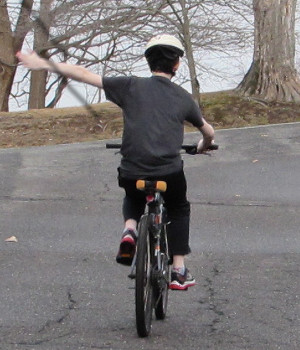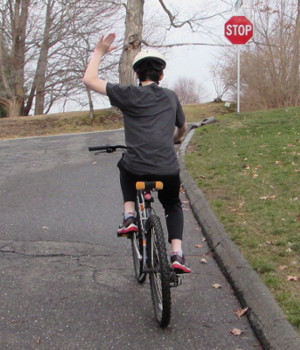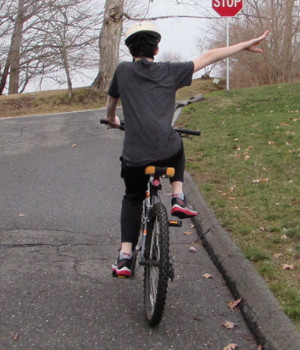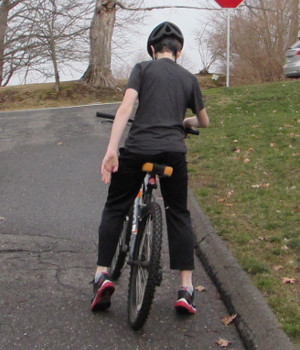Overview
Bicycling is a great form of entertainment, exercise and transportation. Children of many ages can enjoy biking with their families or friends.
Common injuries
Children of any fitness level can enjoy cycling, and it is rare to see overuse injuries due to recreational biking. Bruises and scrapes are the most common injuries. More serious injuries include muscle strains, sprains and broken bones. Collarbones and wrists are the bones most frequently broken. The most common mechanism of injury is falling off the bike onto an outstretched hand. More serious mechanisms are flipping over handlebars or being struck by a car. These rare events can result in head injuries or even death.
The Consumer Product Safety Commission reported that bicycle riding resulted in over 400,000 children’s injuries requiring emergency room treatment in 2000. Approximately 17 of every 1000 riders were treated at a hospital. (1)
Safety Hand Signals

Left Turn

Right Turn

Right Turn (alternative)

Stop Signal
Recommendations for Safe Biking
- Wear a helmet - According to the Centers for Disease Control and Prevention, emergency departments treat 26,000 bike related traumatic brain injuries in children each year. Parents should be good role models and wear helmets when biking with children.
- Obey traffic laws and signs - While biking on public roads, you are considered a vehicle. You are expected to ride on the right side of the road with traffic. You should use hand signals before stopping or turning. You should stop at stop signs and traffic lights and look both ways before entering a street or intersection.
- Ride defensively - Anticipate that drivers will not see you.Look ahead for road hazards such as downed branches or potholes.
- Avoid high traffic areas - Try to take routes with less traffic to lessen the chance of an accident.
- Have your eyes and ears open - Distracted riders may not hear the warning of a horn or siren. Never ride a bike with headphones or while talking or texting on the phone.
- Remember night safety - Always wear reflective clothing and use reflectors or lights if biking at dusk, dawn or night.
- Do not operate a bike under the influence - It is always a bad idea to operate any equipment under the influence of drugs or alcohol.This includes a bike.
- Slippery conditions are dangerous - Be extra cautious when road conditions are slippery, wet or icy.
- Keep up maintenance - Be sure to maintain your bike.Clean your bike and check the chain, tire pressure and brakes before operating. Adjust the bike as you grow so that it always fits properly.
- Wear proper clothing - Clothing should fit well without any loose or hanging parts. These can become entangled in pedals or gears.
- Plan for the distance - Biking is a sport and requires conditioning.Do not take a lengthy bike ride as your first of the season.Be sure you are in appropriate shape for the length of trip you have planned.
- Hydrate - Be sure to drink plenty of water before a day of biking.
- Supervise - Small children and new bikers should be directly supervised.Older children should have a plan to check in with a parent when they arrive at their destination or a way to communicate an accident.
More Information:
References:
- Recreational Injuries in Children: Incidence and Prevention, J.M. Purvis, MD et al, Journal of the American Academy of Orthopaedic Surgeons, November/December 2001, Vol. 9. No. 6, 365-374
Q: I am planning to get my child a bike for his birthday. Are there features I should look for?
- The safest bike is one that fits your child. Get one that the child can control well. Set the seat so that his knees come just straight with the pedal at the bottom and set the handlebars at chest level or lower for best control.
- If getting a used bike, take it to a bike shop for a tune up to make sure:
- the brakes work
- the chain and gears are in good repair
- tires have the correct pressure
- Make sure the bike has good reflectors.
Q: How can I improve my child’s safety while riding her bike?
- Make sure your child always wears a helmet while riding her bike
- Always supervise your child riding a bike until experience allows more freedom
- Teach your child the rules of the road
- Ride on the right side of the road with traffic
- Respect car traffic and traffic signals
- Stop at stop signs and traffic lights
- Check both ways before entering an intersection
- Signal your intentions with hand signals
- Expect that cars won’t see you – ride defensively
- Don’t allow your child to ride a bike at night or in poor weather conditions
- Have your child avoid high traffic areas
- Don’t let your child ride a bike with a headset on. It is important to hear horns and sirens warning of danger
Q: What safety equipment does my child need to ride his bike?
- Children should always wear a helmet when riding a bike
- If new to biking, training wheels will help with balance
- Secure shoes are recommended. Foot injuries are common in children who fall from a bike in flip-flops or other popular slip on shoes
Q: My child wants to participate in a long distance ride for charity. Is that OK?
- Biking requires repetitive use of large muscles. Be sure that the distance is well within your child’s level of conditioning
- Make a plan for your child if she needs to end the ride in the middle
- If your child has asthma or any medical condition, consult your pediatrician before participation
- Hydrate appropriately for a long distance ride
- Wear appropriate clothing for the anticipated weather and any changes that might occur
Q: Where can I get more information about bike safety?

 POSNA.org
POSNA.org



